He was lowered only twice ... History of St. Andrew's flag
Apostle Andrew the First-Called, one of the twelve disciples of Jesus Christ, was, according to legend, crucified precisely on an oblique cross. Apostle Andrew went with a sermon in a number of countries that fell to him by lot. Andrei the First-Called preached in Bithynia, Ponte, Thrace, Macedonia, Thessaly, Hellas, Achaia and Scythia. He became the first preacher of Christianity on the Black Sea coast, while his sailors and fishermen listened.
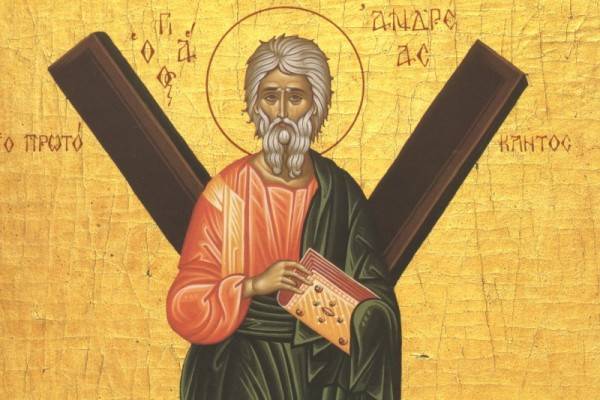
The authorities greeted him very unfriendly, and in Sinop he was subjected to cruel torture. It is believed that the apostle visited the territory of modern Abkhazia, Adygea and Ossetia, and then returned to Byzantium, where he also continued his sermon, founded the Church. Then Andrew the First-Called was captured and died in the city of Patras, in the territory of Greece. Oblique cross, which became the instrument of execution of St. Andrew the First-Called, in memory of the apostle was nicknamed St. Andrew's. At the place where Andrew was crucified, the source was scored. Now in Patras there is a very beautiful cathedral of St. Andrew the First-Called, dedicated to the apostle.
The birth of a flag with an oblique cross is associated with the events of later centuries. In 832, the Scots and Picts of Scotland fought the Angles. King Angus II made a vow that if his army of Scots and Picts won, he would declare Apostle Andrew the First Called Patron of Scotland. And indeed, the victory over the Angles was won, which convinced the Scots and the Picts - they were helped by Andrew the First-Called. The flag of Scotland was a white oblique cross on a blue cloth.
When the personal union of England and Scotland was concluded in 1606, the oblique cross became a component of the flag of the unified state. He is present on the national flag of the UK, if we look closely, and now.
Did this flag affect Peter I? Most likely, for England by that time was already a serious maritime power, one of the strongest in the world. On the other hand, Andrew the First-Called was also considered the patron of Russia. There was a legend that he allegedly traveled around the lands where the Russian state subsequently appeared, and preached the teachings of Christ here. Of course, this is only a legend. After all, the oldest set of 1039 of the year and the Starting set of 1095 of the year, “Reading about Boris and Glebe”, declare that the apostles of Jesus Christ did not go to Russia. Nevertheless, from the XI century, the Apostle Andrew the First-Called was considered the patron saint of the Russian land. Therefore, the choice of Peter was quite reasonable and, moreover, very accurate.
Peter I perfectly understood the significance of symbols for strengthening the unity of the state, for raising the morale of the army and navy. But they needed such symbols that would make any Russian person be in awe of them. The characters associated with the saints were best suited for this role. Andrei Pervozvanny was one of the most revered Christian saints in Russia, and Peter understood this very well when in 1699 he approved a flag with a blue oblique cross on a white cloth with the flag of the Russian fleet.
It is known that the emperor, who paid great attention to the construction and strengthening of the fleet, personally worked on the sketch of the new flag. He tried at least eight options. They tried to use them as sea flags, until in 1710, the sovereign did not stop the choice on the final version - the same white flag with a blue oblique cross. However, only the 1720 Charter of the Year defined the exact characteristics of the flag - “The flag is white, there is a blue St. Andrew’s cross, which he christened Russia with”.
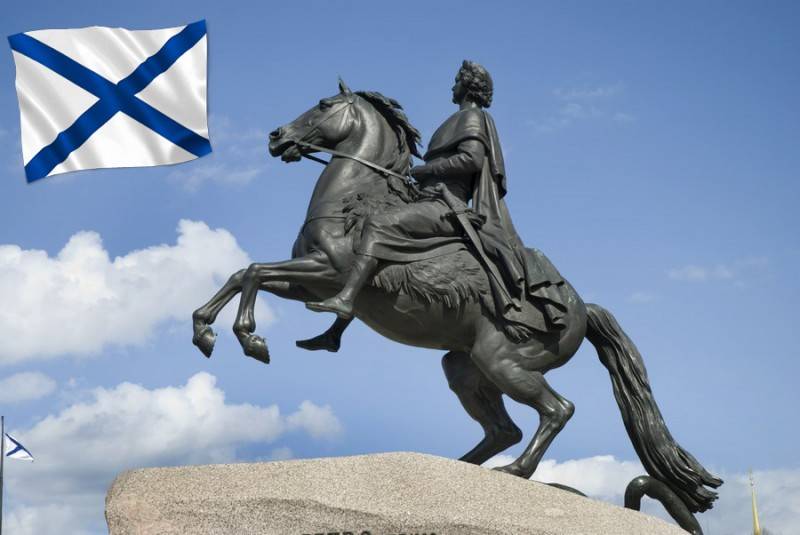
Already in the XVIII century, St. Andrew’s flag was covered with the glory of sea battles, in which Russian fleet ships participated under it. Numerous Russian-Turkish wars, expeditions to faraway countries - all this took place for the fleet under the flag of St. Andrew. Naturally, the sailors veneration of the St. Andrew's flag has become a real tradition. He became the main shrine of the Russian naval sailor, his pride.
Usually, the flag of St. Andrew raised above the ships was a four-meter-high cloth. This size was not accidental - a large banner in the wind made a noise that frightened the enemy and was a kind of psychological weapons. One can imagine how the St. Andrew's banners of the Russian squadrons, which included a large number of ships, "roared"! Indeed, the enemy was not at all frightened by such an awesome roar.
With the development of the Russian fleet, its participation in all new and new wars, the St. George Admiral's flag was adopted in 1819, which was the same St. Andrew's flag, in the center of which was a red heraldic shield, and on it was an image of St. George the Victorious, considered one of the patrons of the warriors of the Russian Land. To receive such a flag to the ship's crew was considered a great honor. He was awarded for special military merit, for example - for the courage shown in defending the flag of St. Andrew during a naval battle.
By the way, St. Andrew’s flag as the shrine of the fleet was supposed to protect not for life, but for death. The sailors died, but refused to lower the sacred symbol of the Russian fleet. Only twice in history did Russian ships voluntarily lower the St. Andrew flag. The first time it was 11 on May 1829 of the year. During the next Russo-Turkish war, the Rafail frigate, commanded by the captain of the 2 rank, Semyon Stroynikov, collided with a Turkish squadron of 15 ships. The captain did not want his sailors and officers to die, so he decided to lower the flag and surrender the ship.
Emperor Nicholas I was very jealous of military glory. Therefore, when it became aware of an act disgraceful to the fleet, the frigate Raphael was ordered, if it were suddenly captured by Russian sailors, to be burned. Captain 2 rank Semyon Stroynikov was demoted to simple sailors, deprived of awards and titles. The emperor forbade Semyon Stroynikov to marry so that he would not give Russia a “cowardly offspring”. True, by that time Semyon Stroynikov was already the father of two sons. And what is interesting, they did not just enter the naval service, but both of them rose to the rank of rear admiral.
As for the frigate “Rafail”, it was really befell the fate prescribed by Emperor Nicholas I. After 24, after its surrender to the Turks, during the Battle of Sinop, the frigate was burned. The order of the emperor was executed by the famous admiral Pavel Nakhimov. The name "Raphael" was forbidden to give ships of the Russian fleet forevermore.
The second sad story occurred during the Tsushima battle. Then the Second Pacific Squadron, faced with the superior forces of the Japanese fleet, was forced to capitulate. Rear Admiral Nikolai Ivanovich Nebogatov, who served as the junior flagship of the squadron and replaced the wounded commander of Vice Admiral Rozhestvensky, decided to surrender. He also hoped to save the lives of the remaining officers and sailors. St. Andrew’s flags were lowered on ships that surrendered to the Japanese.
Rear Admiral Nebogatov, who decided to surrender the squadron, managed to save the lives of 2280 Russian sailors - officers, conductors and sailors. All these were living people - someone's fathers, brothers, sons. But such a unique act of the admiral was not appreciated by the staff commanders in St. Petersburg and the authorities of the Russian Empire, who considered concern for the preservation of the lives of their subordinates as banal cowardice. When, after the Portsmouth Peace, Rear Admiral Nebogatov was released from captivity and returned to Russia, he was deprived of officials, put on trial, and in December 1906 was sentenced to death. But by higher decree, the sentence to the rear admiral was replaced with a ten-year imprisonment in the fortress, and after 25 months he was released, having received a pardon.
But there was a third case in the history of the Russian fleet, when St. Andrew’s flags were lowered on Russian ships. In 1917, the flag of St. Andrew’s ceased to be the flag of the Russian fleet, and in 1924, it was voluntarily lowered on ships of the Russian squadron in the port of Bizerte on the African coast of the Mediterranean Sea. This was due to the fact that France, which then owned the port of Bizerte, officially recognized the Soviet Union and, therefore, the Russian ships were simply forced to obey the orders of the French colonial authorities.
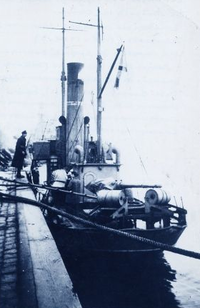 One very interesting story is connected with the revolutionary events and the St. Andrew’s flag. In 1920, the minesweeper Kitobo, commanded by Estonian lieutenant Oscar Fersman, left Estonia for fear of being captured by the Bolsheviks. The commander of the minesweeper ordered to raise the flag of St. Andrew, then headed through Europe towards the Crimea, intending to join the forces of Baron Wrangel.
One very interesting story is connected with the revolutionary events and the St. Andrew’s flag. In 1920, the minesweeper Kitobo, commanded by Estonian lieutenant Oscar Fersman, left Estonia for fear of being captured by the Bolsheviks. The commander of the minesweeper ordered to raise the flag of St. Andrew, then headed through Europe towards the Crimea, intending to join the forces of Baron Wrangel. However, when 27 February ship arrived in Copenhagen, where the British squadron was located, its command ordered Fersman to lower the flag of St. Andrew. The commander of the British squadron stressed that London no longer recognizes the flag of St. Andrew. But Lieutenant Fersman refused to obey the orders of the British, emphasizing that he was ready to engage in an unequal battle, although his ship had only two guns.
It is likely that this controversial situation would have been resolved by armed conflict and the death of Russian sailors in an unequal collision with the English squadron, but the empress Maria Feodorovna intervened, who by happy coincidence was in Copenhagen at that moment. She appealed to the British leadership and achieved not only further passes for the ship, but also its supply of coal and food. As a result, the Whaler nevertheless reached Sevastopol, and then, with the rest of the Wrangel squadron, retired to Bizerte. This was one of the last battles of the sailors of the old Russian fleet for the holy flag of St. Andrew.
In the Soviet Union, a completely different flag was adopted for the Navy, built on the basis of traditional Soviet symbols - sickle, hammer, red star. In the history of the use of the St. Andrew’s flag, more than seventy years of delay came, overshadowed by very unseemly events. During the Great Patriotic War, the flag of St. Andrew began to use the symbolism of the “Russian Liberation Army” by General Andrei Vlasov, who fought against the Soviet Union on the side of Nazi Germany. St. Andrew’s flag was depicted on the chevrons of the ROA military uniform and the traitors who were wearing it on their hands committed crimes against their own people, serving the Führer, the bloody executioner of the Russian land. However, after the war, knowledgeable people understood perfectly well that Vlasovism could not darken the centuries-long history of the St. Andrew’s flag as a symbol of the heroic Russian fleet.
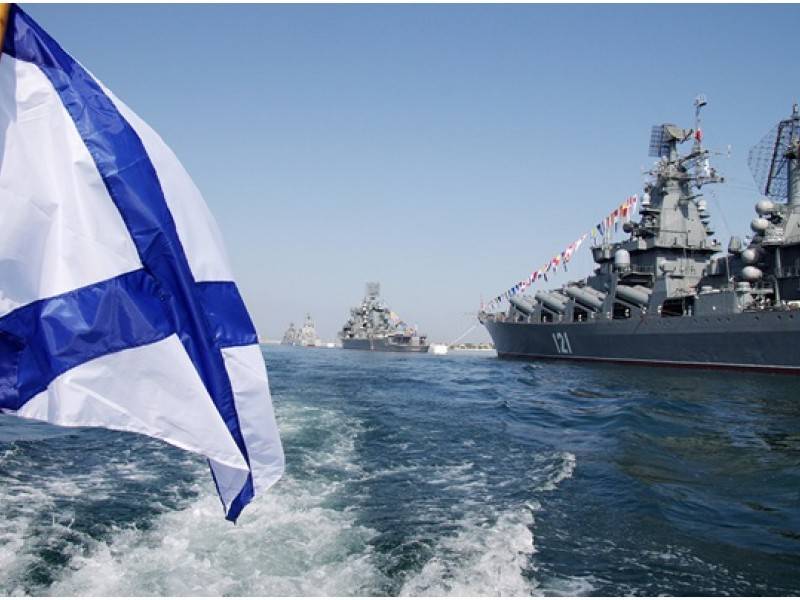
In January, 1992, the government of sovereign Russia decided to revive the flag of St. Andrew as a symbol of the Navy of the Russian Federation. Thus, a tribute was paid to the centuries-old traditions of the Russian fleet. 26 July 1992 was the last time the flags of the USSR Navy were raised on ships of the Russian fleet, after which the anthem of the Soviet Union was played, to the sounds of which they were lowered and St. Andrew flags were raised instead of the Russian Federation. From this time on, the St. Andrew’s flag is the official flag of the Navy of the Russian Federation and is raised on all ships and vessels belonging to it. Symbols with the St. Andrew’s flag are used in the uniform of the personnel of the Russian Navy.
With all due respect to the flag of the USSR Navy and the heroic deeds that Soviet sailors performed under it during the Great Patriotic War, in military campaigns and post-war operations, one cannot but agree that the return of the St. Andrew's flag as a symbol of the Russian fleet was a true revival of traditions, and today, Russian sailors once again appreciate and love the St. Andrew’s flag, keep him loyal. As the Russian captains said when their ships entered the battle - “God is with us and St. Andrew’s flag!”
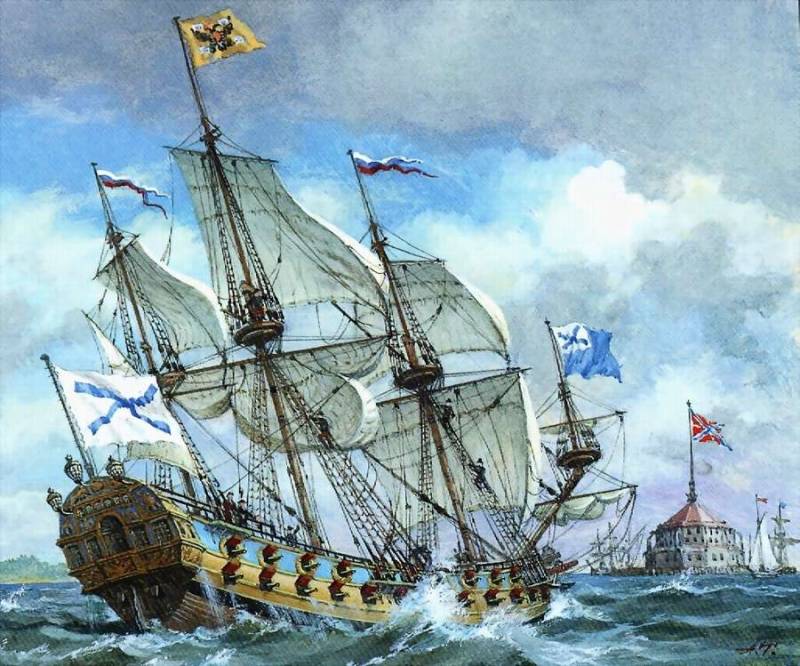
Information